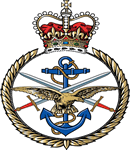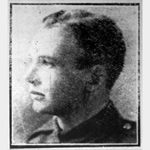Commemorated: | |||
| 1. Memorial: | Bellicourt British Cemetery | III. C. 5. | |
| 2. Book: | The (1921) Masonic Roll of Honour 1914-1918 | Pg.130 | |
| 3. Memorial: | The (1940) Scroll - WW1 Roll of Honour | 21A GQS | |
| 4. Memorial: | Liverpool Masonic Hall War Memorial | Col.3. Hope St. | |
Awards & Titles: | |||
Family :
Ward of Mrs. Elizabeth Taylor of Crewe Farndon Chester.See also: Royden History - Moscate Biography. All credit to Mike Royden for an incredibly detailed biography, which is repeated in part below:
"Frank Moscate had an eventful life in his tragically short existence. He had risen from a difficult childhood to be a manager of a saddlers business in Liverpool, had been called up in the conscription of 1916, served in the Royal Field Artillery, the Royal Engineers and the Tank Corps, and had made quite a mark on those he had met, worked and served with, not least his fiancée back in Liverpool.
Frank entered the world into difficult circumstances. Born on 1 August 1893 at 2 Bernhardts Terrace, Chester, his mother was Johanna Moscati (original spelling of the name), but his father was stated as 'unknown'. Johanna was born Johanna Henderson Leslie in Liverpool in 1858, the daughter of Scottish parents - father George Leslie, a commercial traveller, and mother Catherine Neish. By 1871 she was working as a factory hand, and in 1881 she was a domestic servant, boarding at 248 Exeter Street, Bradford.
Two years later in October 1883, she married Stephen Moscati (born 1862) in Bradford. It was a tragically short union, her new husband dying from rheumatism and heart disease the following year. Four years later she had a son, Robert Leslie Moscati, born in Nov 1888, father 'unknown', but the child died days later in December.
By 1893 Johanna had relocated to Chester, where she gave birth to her second illegitimate son, Frank Ernest Lewis Moscati. She soon secured work, as a domestic servant, then as a cook at Trevalyn Hall, Rossett, a mansion originally built for the powerful Tudor Trevor family. Clearly, an unmarried mother with an illegitimate child was unlikely to hold such a post in the home of a respectable Victorian hall, therefore Johanna may have muddied the waters by using her status as a widow to cover her situation. Nevertheless, it may have been impossible for her to reside 'downstairs' with an infant. This may explain why young Frank had become a 'ward' of Mrs Elizabeth Taylor of Crewe-by-Farndon (evident on the census of 1901- this status continued until his death and he was still on the electoral roll for Crewe-by-Farndon in 1918). Later in life Johanna seems to have achieved happiness, as she remarried in the summer of 1902 to George William Davies. However, it was to last only six years as she died in Wrexham in 1908."
Service Life:
Campaigns:
- The First World War 1914-1918, World-wide.
| Unit / Ship / Est.: 4th Btn Tank Corps |
| Action : The Battles of the Hindenburg Line and associated actions |
12 September - 12 October 1918. As the momentum of the British advance continued it was clear that the Hindenburg Line defences offered the greatest threat to further advances. It was highly likely that the magnificently engineered defence system would re-establish the status quo of static trench warfare. However a series of magnificent actions at Havrincourt and Epehy paved the way for dramatic crossings of the Canal du Nord and the St Quentin Canal by early October. Both canals had been integrated into the Hindenburg Line system and their capture effectively broke the defensive capability of the system. Soon afterwards the British were attacking at Cambrai (again) and then by mid October were pursuing the Germans to the River Selle.
Detail :
In January 1916, Frank heeded the call up, conscription having just been introduced for the first time. He joined the Royal Field Artillery as a gunner, but was quickly transferred to the Royal Engineers and then the newly formed Tank Corps where he was promoted to Lance Corporal. He was assigned to the 4th Battalion Tank Regiment, which had been formed in 1917.
These were the pioneering days for the Tank Corps, originally being formed as Companies of the Heavy Section Machine Gun Corps, designated A, B, C and D. Each Company consisted of 4 Sections of 3 tanks of each type. Companies had another machine in reserve. In November 1916, the Companies were expanded to Battalions, carrying the same letter designations. An expansion programme was ordered by GHQ, to build a force of 14 additional Battalions. The Tank Corps was formed from the Heavy Branch MGC on 27 July 1917, and the Battalions adopted numbering rather than letter designations.
It is gratifying to know we have a local hero who was involved in the pioneering days of the Tank. After extensive training in the new battle machines, he arrived in France in January 1918, and was soon in action. The specific movements of the 4th battalion are not yet known, but this extract from The Long Long Trail (www.1914-1918.net/tanks.htm) gives a flavour of the action the tanks were involved in; ‘When the German army attacked in March 1918, British tanks were little used as a defensive weapon, but played an important part in the extraordinary counter-attack at Villers-Bretonneux on 24-25 April. During this action they faced for the first time the few German tanks that were ever produced. (The Germans also used captured British tanks, mostly from Cambrai). On 4 July 1918 at Le Hamel and in front of Amiens on 8 August 1918, tanks played a central role in the crushing success of the Allied attack. Before Hamel, the Australian Corps carried out intensive training with the tanks in order to overcome lingering doubts after Bullecourt and to tighten up infantry/tank cooperation. 450 of them took part in the Amiens attack, where the Whippets and various armoured cars penetrated deep behind the German defences. In conjunction with the new artillery and infantry tactics, tanks proved to be useful in crushing wire; overrunning machine gun posts and strong points; helping infantry through the streets of destroyed villages. However, tank losses were significant and within days of the initial Left: A postcard sent home by Gunner Ernest Powell (4th Battalion, Tank Corps) to his mother. Powell was in the same battalion as Frank.
Obituary notice placed in the local Liverpool press by Lillian Brown assault the Tank Corps was a temporarily spent force. It was not until the assaults on the Hindenburg Line in late September 1918 that a large enough force had been assembled again. From 21 August 1918 to the Armistice on 11 November 1918, some 2,400 men and officers of the Tank Corps became casualties.’
It was this engagement on the Hindenburg Line in late September 1918 in which Frank lost his life. The local Liverpool press were informed and carried the following story:
"News has reached Gateacre of the death in France of Gunner [sic] Frank E. Moscate of the Tank Corps, as the result of an enemy shell burst while he was returning from action on 29th September. Twenty-five years of age, he was a native of Farndon, Cheshire, but had lived for six years with Mr T.H. Mullock of Garston, by whom he was employed. For four years he managed Mr Mullock's saddlery business at Gateacre, and was very popular there and at Garston. He joined up in January 1916, and was first in the Royal Field Artillery, being afterwards transferred to the Royal Engineers and then to the Tank Corps. He went to France eight months ago. The officer in charge of his section writes:- "He had just left the Tank and was returning to the base when a shell burst directly amongst the crew. Frank and the corporal were killed instantaneously, and three others were badly wounded. I have only been his crew officer for a little over a month, and already I had begun to like him as a man, and appeared to appreciate him in every way. He was always very plucky, and very much liked by everyone in the company. I sympathise with you from the bottom of my heart."
The Revered Allen Hobbes, chaplain, in a message to his mother says:-
"He was walking with his officer and other comrades on the side of the hill not in view of the enemy near (censored) when a shell fell in the midst of the corps, and killed two, including Frank, and wounded several others. He was buried a few hours later near to the spot where he fell. The news will come to you as a sudden shock and a surprise, but you will, I hope, be comforted in knowing that he had done his best and the highest that any man could do - he has given his life for his friends. He was much liked by his comrades and officers, and was thought very highly of by all because he was fearless in the carrying out of his duty, and unselfish in the disregard of his personal safety."
Miss Lillian Brown of Gateacre, his fiancee, for whom sympathy is felt, has received a letter of sympathy, among others, from the Pembroke Lodge of Freemasons, of which Gunner Moscate was a member."
Masonic :
| Type | Lodge Name and No. | Province/District : |
|---|---|---|
| Mother : | Pembroke No. 1299 E.C. | West Lancashire |
Initiated | Passed | Raised |
20th January 1916 | 17th February 1916 | 16th March 1916 |
The masonic record show him listed as a 23 year old harness maker at time of initiation in 1916. His line in the contribution record shows that he "Died 1918 on Active Service."
Source :
The project globally acknowledges the following as sources of information for research across the whole database:
- The Commonwealth War Graves Commission
- The (UK) National Archives
- Ancestry.co.uk - Genealogy, Family Trees & Family History online
- ugle.org.uk - The records of the United Grand Lodge of England including the Library and Museum of Freemasonry
Additional Source:
- Founder Researchers : Paul Masters & Mike McCarthy
- Researcher : Bruce Littley

